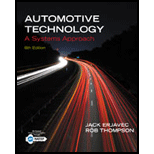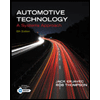
Automotive Technology: A Systems Approach (MindTap Course List)
6th Edition
ISBN: 9781133612315
Author: Jack Erjavec, Rob Thompson
Publisher: Cengage Learning
expand_more
expand_more
format_list_bulleted
Concept explainers
Textbook Question
thumb_up100%
Chapter 3, Problem 3RQ
Explain Newton’s second law of motion and give an example of how this law is used in automotive theory.
Expert Solution & Answer
Want to see the full answer?
Check out a sample textbook solution
Students have asked these similar questions
Explain in detail about Vehicle Aerodynamics
The age of a car driven is qualitative or quantitative and why?
If self-driving automobile technology continues to improve and becomes more and more commonplace, are there any markets (products or
services) whose demand might be affected by the rise of that technology?
Chapter 3 Solutions
Automotive Technology: A Systems Approach (MindTap Course List)
Ch. 3 - Describe Newtons first law of motion and give an...Ch. 3 - In what four states does matter exist? Cite...Ch. 3 - Explain Newtons second law of motion and give an...Ch. 3 - Describe five different forms of energy.Ch. 3 - Describe four different types of energy...Ch. 3 - Explain why a rotating, tilted wheel moves in the...Ch. 3 - Why are gases and liquids considered fluids?Ch. 3 - Describe how out-of-balance forces can affect the...Ch. 3 - Describe the effect of pressure on an enclosed...Ch. 3 - The nucleus of an atom contains and
Ch. 3 - Which of the following is the correct formula used...Ch. 3 - Work is calculated by multiplying by.Ch. 3 - Prob. 13RQCh. 3 - Name three types of simple machines.Ch. 3 - When one object is moved over another object, the...Ch. 3 - Weight is the measurement of the earths on an...Ch. 3 - Torque is a force that does work with a action.Ch. 3 - Explain why elastic mounts are used to connect the...Ch. 3 - Vacuum is defined as the absence ofCh. 3 - While discussing different types of energy:...Ch. 3 - While discussing friction in matter: Technician A...Ch. 3 - While discussing mass and weight: Technician A...Ch. 3 - When applying the principles of work and force,...Ch. 3 - All these statements about energy and energy...Ch. 3 - Which of the following is not a true statement...
Knowledge Booster
Learn more about
Need a deep-dive on the concept behind this application? Look no further. Learn more about this topic, mechanical-engineering and related others by exploring similar questions and additional content below.Similar questions
- Describe Newtons first law of motion and give an application of this law in automotive theory.arrow_forwardWhich of the following have had a significant impact on the automotive industry? a. Emission laws b. Electronics c. New technologies d. All of the abovearrow_forwardGive a brief explanation of why electronics are so widely used on today vehiclesarrow_forward
- From Bartov’s observations, what are the pluses and minuses of America’s car culture? In what ways was the automobile changing American society?arrow_forwardHow do a unicycle and a twoaxle car react differently to road bumps?arrow_forwardWhat theory was used to get the values of acceleration? please explainarrow_forward
- Are car body styles exactly identical between years? Like does a 2009 Dodge Charger look identical to a 2010 Dodge Charger?arrow_forwardThe gas pedal and the brake pedal are capable of causing a car toaccelerate. Can the steering wheel also produce an acceleration?Explainarrow_forwardThe shape of a discus aids the thrower by facilitating Question 6 options: aerodynamic friction and stability from angular momentum aerodynamic lift and stability from angular momentum aerodynamic lift and stability from linear momentum aerodynamic friction and stability from Linear momentumarrow_forward
- Provide examples of event-driven applications in the automotive industry for vehicle safety and efficiency.arrow_forwardWhat is the difference between the friction of rest and the friction of motion, and which provides better braking?arrow_forwardCompare and contrast rear engine rear wheel drive lay out with front engine rear wheel drive.arrow_forward
arrow_back_ios
SEE MORE QUESTIONS
arrow_forward_ios
Recommended textbooks for you
 Automotive Technology: A Systems Approach (MindTa...Mechanical EngineeringISBN:9781133612315Author:Jack Erjavec, Rob ThompsonPublisher:Cengage Learning
Automotive Technology: A Systems Approach (MindTa...Mechanical EngineeringISBN:9781133612315Author:Jack Erjavec, Rob ThompsonPublisher:Cengage Learning Automotive TechnologyMechanical EngineeringISBN:9781337794213Author:ERJAVEC, Jack.Publisher:Cengage,
Automotive TechnologyMechanical EngineeringISBN:9781337794213Author:ERJAVEC, Jack.Publisher:Cengage,

Automotive Technology: A Systems Approach (MindTa...
Mechanical Engineering
ISBN:9781133612315
Author:Jack Erjavec, Rob Thompson
Publisher:Cengage Learning

Automotive Technology
Mechanical Engineering
ISBN:9781337794213
Author:ERJAVEC, Jack.
Publisher:Cengage,
The Laws of Thermodynamics, Entropy, and Gibbs Free Energy; Author: Professor Dave Explains;https://www.youtube.com/watch?v=8N1BxHgsoOw;License: Standard YouTube License, CC-BY